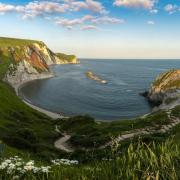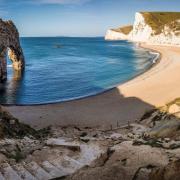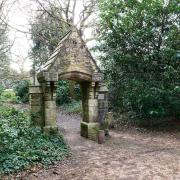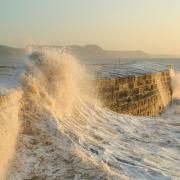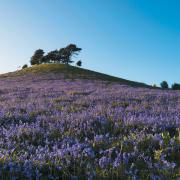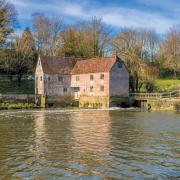What does the beach mean to you? Ian Brighouse, author of The British Beach Guide, reveals why people think Chesil, Branksome Chine and Mudeford Sandbank beaches are so special. Answers range from making family memories to a mindful place to recharge.
Over the last ten years I’ve been travelling around the British coast asking beachgoers the simple question: ‘What does the beach mean to you?’ From this, I’ve discovered that this special place where land, sea and sky meet means different things to different people. For some it enhances creativity, decisiveness and energy, for others it is restorative, settling and calming; it is also a much-loved reference point through generations, a place that represents freedom and fun. Happy memories of spending time with grandparents, parents and children.

I’ve collated these reflections and opinions, alongside my own discoveries from visiting 130 of Britain’s beaches in The British Beach Guide, a guidebook with a difference. Packed full of information, impressions and photographs taken at different times of year, it reflects regional characteristics of our beaches. From the remote wildness of Cullykhan in Aberdeenshire to the bustling working harbour at St Ives in Cornwall. Included in this collation of coastal locations are six Dorset beaches: Lyme Regis, Chesil Beach, Durdle Door, Studland Bay, Branksome Chine and Mudeford Sandbanks.
These Dorset beaches are notable for their variety, as well as their natural beauty. For example, the deep wooded chines and the promenade between Bournemouth and Poole have a sheltered metropolitan feel with easy access to seven miles of golden sands, ideal for bucket and spade family fun. Whereas Chesil Beach’s 18-mile stretch of graduated pebbles is a much wilder and remote location.

The beach, by its very nature, is ever-changing; twice daily tides (high and low), the seasons and the weather all play their part. Which in turn guarantees an element of anticipation and excitement in any beach visit. You don’t know what you’ll see or who you’ll meet, which means that when I asked: ‘What does the beach mean to you?’ There is always a different answer.
Find out more at manonabeach.com
The British Beach Guide by Ian Brighouse is published by Whittles Publishing at £18.99

Chesil Beach...the sound of the sea
This famous 18-mile-long pebble beach stretches northwest from Portland to West Bay, behind it is the Fleet Lagoon. The area of shallow sand dunes overlaying shingle that points east and inward towards Portland harbour is known as Hamm Beach. Chesil Beach and Fleet Lagoon are in the centre of the Jurassic Coast, a 96-mile stretch of coastline running from Exmouth in East Devon to Studland Bay in Dorset. Spanning 185 million years of geological history, it was designated a UNESCO Natural World Heritage Site in 2001. There’s prolific wildlife at Chesil, including a little tern colony in the Fleet Nature Reserve. I remember the spectacular sight of the full length of the beach including the Fleet, laid out in front of me as I descended by road towards the Abbotsbury end of Chesil Beach.
What does Chesil Beach mean to you?
‘It’s a wild place. All you get is the sound of the sea, the crunch of the shingle and the noise of the birds. The beach is graded in size with the stones, from pea-sized at West Bay to cobble-sized at the Portland end. The closest landfall at right angles to this beach is South America.’ John
‘For me, the beach is a very particular kind of quiet. There isn’t really a sound like it, yet at the same time you can hear sounds from a long way away as well.’ Andy
manonabeach.com/dorset/chesil-beach

Branksome Chine...a place to relax
A chine is a wooded valley that runs down from higher ground, in this case cliffs, to the sea. There are four such chines on the long sandy beach between Poole and Bournemouth, namely Branksome, Branksome Dene, Alum and Durley. Branksome Chine has a wide sandy beach with a gradual slope into the sea, part of a seven-mile-long strand of beach that runs between Poole in the west all the way to Hengistbury Head in the east. This section of beach is backed by tall cliffs that display vivid yellow gorse in season. It’s a Blue Flag beach with a beach office and lifeguard cover from May through to September. An excellent restaurant by the beach is frequented by celebrities. Although this is a well-to-do area, the beach and its views are still natural and sensational. Windsurfers can be seen riding the waves, particularly at the weekend. Other beach goers prefer a run or a walk along a promenade that is blessed with a choice of restaurants and ice cream parlours.
What does Branksome Chine mean to you?
‘In one word, relaxation. Whether you’re going for a gentle stroll, running, cycling, swimming in the sea, with family and friends on the beach, you cannot beat the beauty of being on the beach. We’re very spoilt here, because we have one of the finest beaches in the whole country.’ David
‘The beach is fantastic for me. I come down whenever I can. I like to have my swim, I get rid of all the troubles that are surrounding me, and then sit on the beach with a nice cup of coffee, totally relax and warm up in the sunshine. The beach is a little place where I can come just on my own, although I have got plenty of friends down here as well.’ Dave
manonabeach.com/dorset/branksome-chine

Mudeford Sandbank...making family memories
Mudeford Sandbank sits next to Hengistbury Head, overlooking Christchurch Harbour and forming a natural barrier between the harbour and the open sea. There’s an adjacent lagoon where you can see birds such as red shanks, oyster catchers and terns, it’s also home to the rare natterjack toad. The area is designated as a Site of Nature Conservation Interest and can be reached in a variety of ways, either by foot, bicycle or land train from Hengistbury Head, or by ferry from Mudeford and Christchurch Quays. There are about 300 beach huts on Mudeford Sandbank. They are unique, and highly sought-after, because you can sleep in them overnight, so a community spirit has grown here. There’s also a chic café, but the main attraction is the work of nature, a finger of powder fine sand in an idyllic location. Safe dinghy sailing, windsurfing and wonderful wildlife are all to hand. There is a Visitor Centre by the car park. I recommend a circular walk from here, taking in Hengistbury Head itself. Walk it on an autumn afternoon to see The Needles and the Isle of Wight basking in the golden light of the seasonal sun.
What does Mudeford Sandbank mean to you?
‘I always said I would eventually live beside the sea and that has happened. I think it is the one thing I would really miss. It’s also a very spiritual thing. If you’re feeling down, it can cheer you up. I just love being able to walk along the beach with the sun in my face and smell the fresh air. I feel fortunate to be here.’ Jan
‘Now we have six grandchildren they all come down to the beach hut here. Some climb up ladders and do a little bit of work, and they all play about in the sand and get messy. They love it down here. That’s why we keep coming back.’ Alec
manonabeach.com/dorset/mudeford-sandbank








